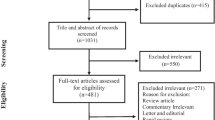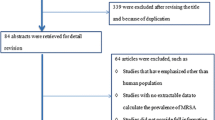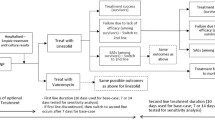Abstract
Mathematical models currently used to study the relationship between the prevalence of the resistance to an antibiotic and the amount of drug may not be adequate because they do not integrate temporal and area analyses simultaneously. Furthermore, the forms of such relationship are unknown. We applied the Generalized Additive Model (GAM) to study fluoroquinolone use and the incidence of fluoroquinolone-resistance in Staphylococcus aureus in our institution over a 3-year period. Overall institution and individual hospital unit-restricted analyses were performed. Relative risk (RR) observed for increasing fluoroquinolone use with a 4-month lag from the 25th percentile to the 75th percentile was 1.27 (95% CI: 1.13–1.42). In the surgery units, RR was 1.23 (95% CI: 1.01–1.50) for fluoroquinolone use with a 2-months lag. GAM enabled us to observe for the first time a significant temporal relationship between fluoroquinolone use and the incidence of fluoroquinolone-resistant nosocomialS. aureus isolates.
Similar content being viewed by others
References
Cohen ML. Changing patterns of infectious disease. Nature 2000; 406: 762–767.
Greenwood D. Preserving the miracle of antibiotics. Lancet 1995; 345: 1371.
Wadman M. Group urges survey of antibiotics in animals. Nature 2001; 409: 273.
Diekema DJ, Pfaller MA, Schmitz FJ, et al. Survey of infections due to Staphylococcus species: Frequency of occurrence and antimicrobial susceptibility of isolates collected in the United States, Canada, Latin America, Europe, and the Western Pacific region for the SENTRY Antimicrobial Surveillance Program, 1997–1999. Clin Infect Dis 2001; 32(Suppl 2): S114-S132.
Fluit AC, Jones ME, Schmitz FJ, Acar J, Gupta R, Verhoef J. Antimicrobial susceptibility and frequency of occurrence of clinical blood isolates in Europe from the SENTRY antimicrobial surveillance program, 1997 and 1998. Clin Infect Dis 2000; 30: 454–460.
Edmond MB, Wallace SE, McClish DK, Pfaller MA, Jones RN, Wenzel RP. Nosocomial bloodstream infections in United States hospitals: A 3-year analysis. Clin Infect Dis 1999; 29: 239–244.
Public Health Laboratory Service. CDR Weekly 1997; 7: 191.
Centers for Disease Control and Prevention. Interim guidelines for prevention and control of staphylococcal infection associated with reduced susceptibility to vancomycin. MMWR 1997; 46: 626–635.
Hanberger H, Diekema D, Fluit A, et al. Surveillance of antibiotic resistance in European ICUs. J Hosp Infect 2001; 48: 161–176.
Vincent JL. Microbial resistance: lessons from the EPIC study. European Prevalence of Infection. Intensive Care Med 2000; 26(Suppl 1): S3-S8.
Acar JF, Goldstein FW. Trends in bacterial resistance to fluoroquinolones. Clin Infect Dis 1997; 24(Suppl 1): S67-S73.
Burman LG, Haeggman S, Kuistila M, Tullus K, Huovinen P. Epidemiology of plasmid-mediated beta-lactamases in enterobacteria Swedish neonatal wards and relation to antimicrobial therapy. Antimicrob Agents Chemother 1992; 36: 989–992.
Arason VA, Kristinsson KG, Sigurdsson JA, Stefansdottir G, Molstad S, Gudmundsson S. Do antimicrobials increase the carriage rate of penicillin resistant pneumococci in children? Cross sectional prevalence study. Br Med J 1996; 313: 387–391.
Richard P, Le Floch R, Chamoux C, Pannier M, Espaze E, Richet H. Pseudomonas aeruginosa outbreak in a burn unit: Role of antimicrobials in the emergence of multiply resistant strains. J Infect Dis 1994; 170: 377–383.
Levine JF, Maslow MJ, Leibowitz RE, et al. Amikacin-resistant Gram-negative bacilli: Correlation of occurrence with amikacin use. J Infect Dis 1985; 151: 295–300.
Seppala H, Klaukka T, Vuopio-Varkila J, et al. The effect of changes in the consumption of macrolide antibiotics on erythromycin resistance in group A streptococci in Finland. Finnish Study Group for Antimicrobial Resistance. N Engl J Med 1997; 337: 441–446.
Crowcroft NS, Ronveaux O, Monnet DL, Mertens R. Methicillin-resistant Staphylococcus aureus and anti-microbial use in Belgian hospitals. Infect Control Hosp Epidemiol 1999; 20: 31–36.
McGowan Jr JE. Antimicrobial resistance in hospital organisms and its relation to antibiotic use. Rev Infect Dis 1983; 5: 1033–1048.
Monnet DL, Archibald LK, Phillips L, Tenover FC, McGowan Jr JE, Gaynes RP. Antimicrobial use and resistance in eight US hospitals: Complexities of analysis and modeling. Intensive Care Antimicrobial Resistance Epidemiology Project and National Nosocomial Infections Surveillance System Hospitals. Infect Control Hosp Epidemiol 1998; 19: 388–394.
Magee JT, Pritchard EL, Fitzgerald KA, Dunstan FD, Howard AJ. Antibiotic prescribing and antibiotic resistance in community practice: retrospective study, 1996–1998. Br Med J 1999; 319: 1239–1240.
Pena C, Albareda JM, Pallares R, Pujol M, Tubau F, Ariza J. Relationship between quinolone use and emergence of ciprofloxacin-resistant Escherichia coli in bloodstream infections. Antimicrob Agents Chemother 1995; 39: 520–524.
Ballow CH, Schentag JJ. Trends in antibiotic utilization and bacterial resistance. Report of the National Nosocomial Resistance Surveillance Group. Diagn Microbiol Infect Dis 1992; 15(Suppl 2): S37-S42.
Mouton RP, Hermans J, Simoons-Smit AM, Hoog kamp-Korstanje JA, Degener JE, van Klingeren B. Correlations between consumption of antibiotics and methicillin resistance in coagulase negative staphylococci. J Antimicrob Chemother 1990; 26: 573–583.
Courcol RJ, Pinkas M, Martin GR. A seven year survey of antibiotic susceptibility and its relationship with usage. J Antimicrob Chemother 1989; 23: 441–451.
Gerding DN, Larson TA, Hughes RA, Weiler M, Shanholtzer C, Peterson LR. Aminoglycoside resistance and aminoglycoside usage: Ten years of experience in one hospital. Antimicrob Agents Chemother 1991; 35: 1284–1290.
Mouton RP, Glerum JH, van Loenen AC. Relationship between antibiotic consumption and frequency of antibiotic resistance of four pathogens: A seven-year survey. J Antimicrob Chemother 1976; 2: 9–19.
Moller JK. Antimicrobial usage and microbial resistance in a university hospital during a seven-year period. J Antimicrob Chemother 1989; 24: 983–992.
Natsch S, Conrad C, Hartmeier C, Schmid B. Use of amoxicillin-clavulanate and resistance in Escherichia coli over a 4-year period. Infect Control Hosp Epidemiol 1998; 19: 653–656.
Lopez-Lozano JM, Monnet DL, Yague A, et al. Modelling and forecasting antimicrobial resistance and its dynamic relationship to antimicrobial use: A time series analysis. Int J Antimicrob Agents 2000; 14: 21–31.
Austin DJ, Kristinsson KG, Anderson RM. The relationship between the volume of antimicrobial consumption in human communities and the frequency of resistance. Proc Natl Acad Sci USA 1999; 96: 1152–1256.
Norris G, Larson T, Koenig J, Claiborn C, Sheppard L, Finn D. Asthma aggravation, combustion, and stagnant air. Thorax 2000; 55: 466–470.
Saez M, Figueiras A, Ballester F, Perez-Hoyos S, Ocana R, Tobias A. Comparing meta-analysis and ecological-longitudinal analysis in time-series studies. A case study of the effects of air pollution on mortality in three Spanish cities. J Epidemiol Community Health 2001; 55: 423–432.
Schwartz J. Air pollution and daily mortality in Birmingham, Alabama. Am J Epidemiol 1993; 137: 1136–1147.
National Committee for Clinical Standards. Minimum Inhibitory Concentration Interpretive Standards. Wayne, Pennsylvania: National Committee for Clinical Laboratory Standards, 1998.
World Health Organization Collaborating Center for Drugs Statistics Methodology. Anatomical Therapeutic Chemical classification index with Defined Daily Doses. Oslo NWHO, 2000.
Hastier TJT, R. J. Generalized additive models. London, 1990.
Schwartz J. Non parametric smoothing in analysis of air pollution and respiratory illness. Can J Stat 1994; 22: 471–487.
Schwartz J, Spix C, Touloumi G, et al. Methodological issues in studies of air pollution and daily counts of deaths or hospital admissions. J Epidemiol Community Health 1996; 50(Suppl 1): S3-S11.
McCullagh PN, J. A. Generalized linear models. London, 1989.
Cleveland WS, Devlin SJ. Robust locally-weighted regression and smoothing scatterplots. J Am Stat Assoc 1979; 74: 829–836.
Akaïke H. Information theory and an extension of the maximum likelihood principle. Akademiai Kiado, Budapest, 1973: 267–281.
Grundmann H, Hori S, Winter B, et al. Risk factors for the transmission of methicillin-resistant Staphylococcus aureus in an adult intensive care unit: Fitting a model to the data. J Infect Dis 2002; 185: 481–488.
Murray BE. Can antibiotic resistance be controlled? N Engl J Med 1994; 330: 1229–1230.
Bonhoeffer S, Lipsitch M, Levin BR. Evaluating treatment protocols to prevent antibiotic resistance. Proc Natl Acad Sci USA 1997; 94: 12106–12111.
Travis J. Reviving the antibiotic miracle? Science 1994; 264: 360–362.
Author information
Authors and Affiliations
Rights and permissions
About this article
Cite this article
Berger, P., Pascal, L., Sartor, C. et al. Generalized Additive Model Demonstrates Fluoroquinolone Use/Resistance Relationships for Staphylococcus Aureus . Eur J Epidemiol 19, 453–460 (2004). https://doi.org/10.1023/B:EJEP.0000027348.92979.94
Issue Date:
DOI: https://doi.org/10.1023/B:EJEP.0000027348.92979.94




